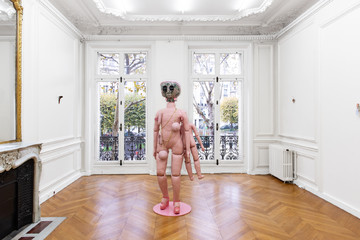Jakob Lena KNEBL
“Ma Poupée” shows the artist Jakob Lena Knebl with a polymorphous female
body in her arms - one of Hans Bellmer’s famous dolls. The doll, which can be
changed via its joints is presented as a sexualised object to the male viewer’s
gaze. Knebl is responding to Bellmer’s photographic stagings of the being -
here she self-confidently makes the doll the object of her own desire.
Knebl’s life-size figures made of leather can also be read as a replica of the
surrealist fetishisation of the female body - between mannequin, sex toy, and
arbitrarily malleable thing. Her figure, titled “Ursula,” wears variably adaptable
female and male sexual organs on a chain around her neck. The ceramic head
of the figure cites the classicism of a Picasso or Modigliani, the pink leather
body, on the other hand, contemporary fetish aesthetics. This queer appropriation
and recontextualisation of male icons of art history, and their inscribed
roles and identities, are typical of Knebl’s play with conceptions of gender and
her construction of new spaces of desire.
Knebl studied sculpture and fashion in Vienna, and in her unique artistic
practice intertwines both fields to create an innovative, art-historically argumentative
language that revolves around bodies, corporeality, and embodiment.
Often embedded in larger scenographies, that transform entire spaces,
she creates works that straddle sculpture, design, installation, video, photography
and performance. Her 2017 exhibition at Vienna’s mumok subjected
works from the museum’s collection to artistic staging and radical reinterpretation,
for example. The negation of supposed boundaries between art and
design, high and popular culture, finds a parallel in the fluid design of gender
identities beyond binary structures. Works of classical modernism integrated
into the performative self-stagings. The different styles and isms of the past
reinterpreted reformed, in a quotation-like manner, that pulls in the viewer,
forcing them to question how such surrounding affect their own being. Another
focus is on the use of culturally charged materials: fabrics and textiles
present themselves as signifiers of bodies, opulently designed displays fetishise
the object on view.
In Jakob Lena Knebl’s art, it is above all the viewer’s expectations that become
the resonating space of the work. Our associations charge the object,
giving it a surprising sexiness. Knebl activates chains of reference that draw
from cultural memory, triggering our own phantasmic internal worlds. “Come
Closer” prompts us to look at a photograph of the artist bending over Oskar
Schlemmer’s “Abstract Figure” from the mumok collection, seeming to enter
into an erotic dialogue with it: another stream in Knebl’s fluid microcosm of
desire.
Text: Vanessa Joan Müller
David FESL
David Fesl’s sculptural objects bear traces of his everyday life, turning the
things he uses regularly into abstract biographical fragments. His precise
assemblages, of the most diverse things of nature and everyday life are
small in size, but in their balanced composition and play with our perceptions
of scale and relation, certainly provide a more monumental evocation
in their specific yet universal forms.
Like a jeweller, Fesl combines the organic and the inorganic, object and
artifice, in a way that allows radically opposing elements to come together
in a surreal yet harmonious way, until a new morphology emerges.
A mucus shell and a scrunchie, a peach stone and an earring, an onion
skin and a screw. In these sophisticated configurations, each individual
part undergoes a metamorphosis in which one component emerges concisely:
its shape, its colour, its texture. Few everyday objects retain their
emblematic charge and recognisable functionality. In the fragile, almost
ephemeral works, the associations triggered by the constituent objects
and their narrative potential, precisely woven together, trace a constellation
of experience and sensory arousal.
The gentle eroticism that characterises these works, suggests a space
beyond fixed attribution: connotations remain variable, evading description,
things appear both masculine and feminine. David Fesl frees what he
seeks and finds from their preconceived limitations, transforming them
into enigmatic forms amongst one another. In an almost painterly way, he
infuses the work with his own hand. His sculptural compositions expose
and transform the meanings of what constitutes them. Things, in a sense,
become queer. In their amalgamation, which is also inherent in a great
craftsmanship, something fascinatingly new emerges, which in its poetic
as well as subtly identity-political visual language situates itself outside
conventional categorisation. The decidedly white surrounding space that
provides the framework adds an institutional-critical component to this
language that underscores Fesl’s extraordinary positioning in the field of
sculpture and incisive social analysis.
Text: Vanessa Joan Müller

